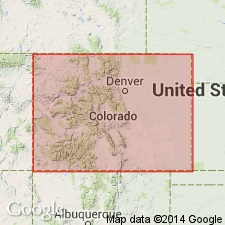
- Usage in publication:
-
- Piceance Creek Sandstone Tongue
- Modifications:
-
- Named
- Dominant lithology:
-
- Sandstone
- AAPG geologic province:
-
- Piceance basin
- Green River basin
Summary:
Named as the basal sandstone of the Green River Formation and as a tongue of the Anvil Points Member of the Green River, presumably for the Piceance Creek basin [though not stated], Rio Blanco and Garfield Cos, CO in the Piceance basin. Formerly assigned to Douglas Creek Member of Green River. Occurs on the east side of the Piceance Creek basin. Extends (areal extent map) from Grand Valley, Garfield Co, north to the Gray Hills in Moffat Co in the Greater Green River basin. Cannot be identified south and west of the Piceance Creek and South Piceance Creek gas fields. No type locality designated. Identified in 1) General Petroleum (Mobil) 84-15-G, sec 15, T2S, R96W between 3047 and 3118; 2) G. P. 18-2-G, sec 18, T2S, R96W between 3085 and 3200; 3) outcrop along south side of White River valley, T1N, Rs96 and 97W, and extends to about sec 33, T2N, R97W. Is 40-50 ft thick on lower Piceance Creek. Consists of 3-4 separate sandstones. [No other lithologic description included.] Cross section. Was derived from an eastern source as was the Anvil Points in contrast to Douglas Creek which had a western source. Eocene age. [Tongue and member bear the same stratigraphic rank; a formal unit cannot be divided into a formal unit of the same rank.]
Source: GNU records (USGS DDS-6; Denver GNULEX).
For more information, please contact Nancy Stamm, Geologic Names Committee Secretary.
Asterisk (*) indicates published by U.S. Geological Survey authors.
"No current usage" (†) implies that a name has been abandoned or has fallen into disuse. Former usage and, if known, replacement name given in parentheses ( ).
Slash (/) indicates name conflicts with nomenclatural guidelines (CSN, 1933; ACSN, 1961, 1970; NACSN, 1983, 2005, 2021). May be explained within brackets ([ ]).

